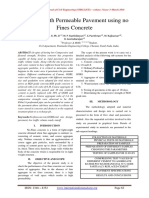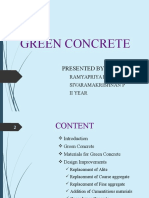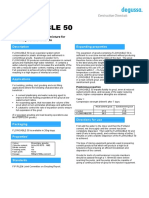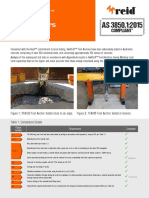Compaction Factor Test&Slump Test Report
Compaction Factor Test&Slump Test Report
Uploaded by
MUN SIM SOHCopyright:
Available Formats
Compaction Factor Test&Slump Test Report
Compaction Factor Test&Slump Test Report
Uploaded by
MUN SIM SOHCopyright
Available Formats
Share this document
Did you find this document useful?
Is this content inappropriate?
Copyright:
Available Formats
Compaction Factor Test&Slump Test Report
Compaction Factor Test&Slump Test Report
Uploaded by
MUN SIM SOHCopyright:
Available Formats
SOH MUN SIM
18WVR05979
On the second lab practical we make the Compaction Factor Test and Slump Test to
determine the work-ability of concrete and determine the effect of slump on
different water/cement ratio and concrete mix.
Same on the cube test, we need to measure the mass of cement, sand and
aggregate by ratio 1:2:4 and mixed it. After mixed the materials, we pour it into the
first level of the Compaction Factor Apparatus and open the trap door level by level
to let the concrete fall into the cylinder on bottom. After that we weight it and
compare with the concrete which is fill by layer and with tamping 25 times for 4
layers.We got the result of 16.2kg which is partially compacted concrete and 17.1kg
which is fully compacted concrete.
According to the result we know that the fully compacted concrete which got
tamping 25 times is heavier than the partially compacted concrete and the
compaction factor is 0.95. By comparing with other group who using the ratio of
1:1:2, we know that the concrete of using the ratio 1:2:4 got more work-ability than
another concrete which compaction factor is 0.97. So that the ratio of 1:2:4 is more
suitable and stable used in construction because of the work-ability.
On the practical of Slump Test, we use the same concrete after the Compaction
Factor Test and add additional volume of water by 0.6 and 0.8 water/cement
ratio.We need to determine that the concrete is collapse slump, shear slump or true
slump.
Before we add water, we think our concrete is too watering and it is hard to add
water again because the water cannot be mixed perfectly. After mix concrete, we
filled it into the slump cone until full and also by four layer and tamping 25 times
each layer. Then we take the cone slowly and put the cone upside down at the side
of concrete and measure the height between the top of the cone and the concrete.
Then we observed the change of the height of the concrete and measure the
difference. Normally our concrete will collapse because of watering.
In the end, we get the result of 160mm by using 0.60 water/cement ratio and
185mm by using 0.80 water/cement ratio. By comparing, the height of concrete after
adding additional water by 0.8 water/cement ratio is weak and watering so we might
use more time to hardening and the concrete will be less work-ability. In my opinion,
the concrete in ratio 1:1:2 is less work-ability of the concrete in ratio 1:2:4 because
the slump is higher, and the concrete is more watering.
You might also like
- Risk Assessment For .TESTING AND COMMISSIONING OF 11 KV CABLEDocument18 pagesRisk Assessment For .TESTING AND COMMISSIONING OF 11 KV CABLEarun kurlan90% (10)
- Workability of ConcreteDocument30 pagesWorkability of ConcreteAdnan Jadoon100% (1)
- AASHTO t99 180Document7 pagesAASHTO t99 180dongpc1No ratings yet
- Calibration Ma27Document4 pagesCalibration Ma27Francisco GomezNo ratings yet
- EIM GRADE 9 10 Q4 Module 1b - National Electrical Code NEC Provisions in Installing Wiring Devices - GFCI. - FinalDocument23 pagesEIM GRADE 9 10 Q4 Module 1b - National Electrical Code NEC Provisions in Installing Wiring Devices - GFCI. - FinalTitser Ramca100% (3)
- Reference: Harmening, D. M. (2012) - Modern Blood Banking & Transfusion Practices (6th Ed.) - Pp. 434Document5 pagesReference: Harmening, D. M. (2012) - Modern Blood Banking & Transfusion Practices (6th Ed.) - Pp. 434Kolin N Jandoc100% (1)
- Diagrama Hidraulico Caterpillar 345cDocument2 pagesDiagrama Hidraulico Caterpillar 345cJose Miguel Gary Vargas100% (1)
- Dark Void (Official Prima Guide)Document161 pagesDark Void (Official Prima Guide)mikel4carbajoNo ratings yet
- David Greig's TheatreDocument293 pagesDavid Greig's TheatreYİĞİT SÜMBÜLNo ratings yet
- Water Cement Ratio (Gate60 Short Notes)Document4 pagesWater Cement Ratio (Gate60 Short Notes)akash rathod100% (1)
- Experimental Study On Concrete Using Copper Slag As Replacement Material of Fine Aggregate 2165 784X.1000156Document6 pagesExperimental Study On Concrete Using Copper Slag As Replacement Material of Fine Aggregate 2165 784X.1000156Siddhesh Kamat Mhamai100% (2)
- Silica Fume 5 PDFDocument14 pagesSilica Fume 5 PDFNour KottiNo ratings yet
- Shrinkage of ConcreteDocument3 pagesShrinkage of Concretegmgoutam550No ratings yet
- No Fines ConcreteDocument5 pagesNo Fines ConcretedannyNo ratings yet
- Liquid and Plastic LimitDocument13 pagesLiquid and Plastic LimitDariusAngelitoNo ratings yet
- Role of Water Cement Ratio On The Cement MortarDocument7 pagesRole of Water Cement Ratio On The Cement MortarPankaj Munjal100% (1)
- Concrete Mix DesignDocument20 pagesConcrete Mix DesignRony BaloyiNo ratings yet
- Replacement of Aggregate With Plastic WasteDocument3 pagesReplacement of Aggregate With Plastic WasteDharma banothuNo ratings yet
- Reference Notes - Tests For ConcreteDocument21 pagesReference Notes - Tests For ConcreteMitali KhedkarNo ratings yet
- Lecture 5 Highway Construction MaterialsDocument15 pagesLecture 5 Highway Construction MaterialsCherylNo ratings yet
- Factors Affecting Durability PDFDocument5 pagesFactors Affecting Durability PDFApoorvaAppiNo ratings yet
- Physical Properties of Aggregates 1Document2 pagesPhysical Properties of Aggregates 1Ahmed Bilal Siddiqui75% (4)
- Green Concrete PresentationDocument17 pagesGreen Concrete PresentationSivaramakrishnan PNo ratings yet
- Fineness Test On CementDocument13 pagesFineness Test On CementTvsp Sekhar50% (2)
- Linear ShrinkageDocument4 pagesLinear Shrinkagelim.chrisNo ratings yet
- Concrete Mix DesignDocument25 pagesConcrete Mix DesigngauravrediffmailNo ratings yet
- Hyper CreteDocument2 pagesHyper CretedjgiumixNo ratings yet
- Cement Testing and Its Importance in Quality ofDocument22 pagesCement Testing and Its Importance in Quality ofGanesh100% (1)
- Cube TestDocument11 pagesCube TestKe Sing100% (2)
- Unit 1aDocument37 pagesUnit 1aDhananjay DesaleNo ratings yet
- Partial Replacement of Cement To Concrete by Marble Dust PowderDocument12 pagesPartial Replacement of Cement To Concrete by Marble Dust PowderIJMTST-Online JournalNo ratings yet
- Is Concrete Mix DesignDocument21 pagesIs Concrete Mix DesignahmedanyNo ratings yet
- Alkali Silica Reaction of ConcreteDocument20 pagesAlkali Silica Reaction of ConcreteArbi811100% (1)
- 3 Aggregate Abrasion Value TestDocument6 pages3 Aggregate Abrasion Value TestAbdur RazzakNo ratings yet
- Elongation and Flakiness TestDocument10 pagesElongation and Flakiness TestHi270693No ratings yet
- TDS - Flowcable 50Document2 pagesTDS - Flowcable 50Venkata RaoNo ratings yet
- Introduction of Cement: When Was Cement Begin?Document11 pagesIntroduction of Cement: When Was Cement Begin?مايف سعدونNo ratings yet
- SANS5842 - FACT Value (10 % Fines Aggregate CrushingDocument4 pagesSANS5842 - FACT Value (10 % Fines Aggregate CrushingAndrew MwindililaNo ratings yet
- Aci 211 Design MixDocument19 pagesAci 211 Design MixJAZPAKNo ratings yet
- Kathmandu University: Construction of Cement Concrete PavementsDocument37 pagesKathmandu University: Construction of Cement Concrete Pavementspasang ghising100% (1)
- Sand Eqivalent TestDocument4 pagesSand Eqivalent TestVishwas Rao100% (1)
- Bond and Compressive Strength of Masonry For Locally Available BricksDocument8 pagesBond and Compressive Strength of Masonry For Locally Available BricksKamran JavedNo ratings yet
- Experiment 2Document5 pagesExperiment 2jp gutierrezNo ratings yet
- Constituent MaterialsDocument69 pagesConstituent MaterialsTejas DoshiNo ratings yet
- ACI Mix Design Example - Pavement InteractiveDocument5 pagesACI Mix Design Example - Pavement InteractiveAbu RaeesNo ratings yet
- Compressive Strength of Concrete - Cube Test Procedure ResultsDocument5 pagesCompressive Strength of Concrete - Cube Test Procedure ResultsAriyan AriyanNo ratings yet
- Bleeding of ConcreteDocument3 pagesBleeding of ConcreteA100% (1)
- Mortar Testing: What Is A MORTAR (MASONRY) ?Document4 pagesMortar Testing: What Is A MORTAR (MASONRY) ?Kelvin LoriaNo ratings yet
- Durability of Concrete: Ashok KumarDocument45 pagesDurability of Concrete: Ashok KumarashoknrNo ratings yet
- Concrete Mix Design: by K.ShahDocument48 pagesConcrete Mix Design: by K.ShahBùi Quang MinhNo ratings yet
- Special ConcreteDocument2 pagesSpecial ConcreteRamprasad KadaliNo ratings yet
- WorkabilityDocument3 pagesWorkabilityyay94rebuildNo ratings yet
- Fineness of Cement by Blaines Air Permeability MethodDocument6 pagesFineness of Cement by Blaines Air Permeability MethodJa Phe TiNo ratings yet
- Tests For Workability of ConcreteDocument5 pagesTests For Workability of Concretelsatchithananthan100% (1)
- SCCDocument10 pagesSCCPrakash NanthagopalanNo ratings yet
- Entroy and Shaclock Mix Design For HSCDocument9 pagesEntroy and Shaclock Mix Design For HSCvempadareddyNo ratings yet
- Concrete Mix Design and Casting of Sample For Different TestDocument4 pagesConcrete Mix Design and Casting of Sample For Different TestAqeel AliNo ratings yet
- Concrete Tech. ManualDocument32 pagesConcrete Tech. ManualaddayesudasNo ratings yet
- Portland Slag CementDocument3 pagesPortland Slag CementamitshresthaNo ratings yet
- Marshall Stability Test: (ASTM D-1663-73, ASTM D-1559-75)Document24 pagesMarshall Stability Test: (ASTM D-1663-73, ASTM D-1559-75)zain IshaqNo ratings yet
- The end of concrete: Pros and cons of an unsuccesful technologyFrom EverandThe end of concrete: Pros and cons of an unsuccesful technologyRating: 1 out of 5 stars1/5 (1)
- Concrete Workability: An Investigation on Temperature Effects Using Artificial Neural NetworksFrom EverandConcrete Workability: An Investigation on Temperature Effects Using Artificial Neural NetworksRating: 5 out of 5 stars5/5 (1)
- Compaction Factor Test&Slump Test ReportDocument1 pageCompaction Factor Test&Slump Test ReportMUN SIM SOHNo ratings yet
- Admixtures in ConcreteDocument3 pagesAdmixtures in ConcreteAlejandroGonzagaNo ratings yet
- Slump Test ReportDocument15 pagesSlump Test ReportRuchiethaa KalaiselvanNo ratings yet
- Slump Test TKYDocument18 pagesSlump Test TKYSurendren SurenkkNo ratings yet
- Use of Steel Slag As Coarse Aggregate For The Production of Pervious ConcreteDocument11 pagesUse of Steel Slag As Coarse Aggregate For The Production of Pervious ConcretemargarethsmNo ratings yet
- Primary Five - Set 20Document5 pagesPrimary Five - Set 20Monydit santinoNo ratings yet
- Invitation Letter PQT AEC & CWCDocument3 pagesInvitation Letter PQT AEC & CWCIqbal Nurrasa BaktiNo ratings yet
- Design and Analysis of Wheel Rim Using CATIA & ANSYSDocument7 pagesDesign and Analysis of Wheel Rim Using CATIA & ANSYSankitsinghal54No ratings yet
- Bca SyllabusDocument55 pagesBca Syllabusapi-349492533No ratings yet
- Digital Image Watermarking Using D.W.T: By: Ashish Kumar (09407) Abhilasha Verma (09401Document17 pagesDigital Image Watermarking Using D.W.T: By: Ashish Kumar (09407) Abhilasha Verma (09401vasantha_eceNo ratings yet
- Theory of Karma: Prepared By: Milind GadhaviDocument15 pagesTheory of Karma: Prepared By: Milind GadhaviMilind GadhaviNo ratings yet
- NEET-Enthuse - Phase 1 - Minor Test - 2 - 29.5.2024 - Q.P.Document31 pagesNEET-Enthuse - Phase 1 - Minor Test - 2 - 29.5.2024 - Q.P.aahanacharanNo ratings yet
- 2.3 GHZ To 4.0 GHZ Watt RF Driver Amplifier: Data SheetDocument16 pages2.3 GHZ To 4.0 GHZ Watt RF Driver Amplifier: Data SheetJuan HernándezNo ratings yet
- Markushevich - The Remarkable Sine FunctionsDocument110 pagesMarkushevich - The Remarkable Sine FunctionsAlfonso HernándezNo ratings yet
- A350-40691 - Rev02 EN13000Document38 pagesA350-40691 - Rev02 EN13000Waleed LemsilkhiNo ratings yet
- 1 s2.0 S1526612521006551 MainDocument10 pages1 s2.0 S1526612521006551 MainIyan MehmoodNo ratings yet
- Reid™ SwiftLift™ Foot Anchors AS3850-2015 ComplianceDocument4 pagesReid™ SwiftLift™ Foot Anchors AS3850-2015 ComplianceAdamMitchellNo ratings yet
- Non Peza ClientsDocument15 pagesNon Peza ClientsDioscoro J. Jebulan100% (1)
- 2008 NRL ReviewDocument250 pages2008 NRL ReviewU.S. Naval Research LaboratoryNo ratings yet
- Eulerian and Mixture Multiphase Models in ANSYS Fluent: Surya Deb Ansys Inc. November 21, 2019Document43 pagesEulerian and Mixture Multiphase Models in ANSYS Fluent: Surya Deb Ansys Inc. November 21, 2019umair35No ratings yet
- GC University Lahore Department of EnglishDocument2 pagesGC University Lahore Department of Englishsyed ahmadullahNo ratings yet
- Research Report 249: Transport and Road Research LaboratoryDocument23 pagesResearch Report 249: Transport and Road Research LaboratorydaraaamaaadiNo ratings yet
- Earth Sci Initial Release June 14 PDFDocument170 pagesEarth Sci Initial Release June 14 PDFJesha mae MagnoNo ratings yet
- Imperium 2Document68 pagesImperium 2Andrew Binks45% (11)
- Sarasvathy Morthy 202302 (Individual Write-Up)Document18 pagesSarasvathy Morthy 202302 (Individual Write-Up)sarasNo ratings yet
- Monopoles and Electricity: Lawrence J. Wippler Little Falls, MN United StatesDocument9 pagesMonopoles and Electricity: Lawrence J. Wippler Little Falls, MN United Stateswaqar mohsinNo ratings yet
- SIP SampleProjectDocument67 pagesSIP SampleProjectanupam.chatterjee23-25No ratings yet

























































































